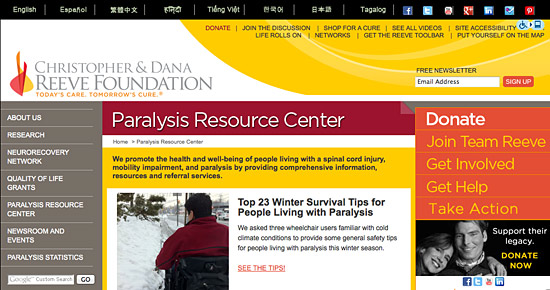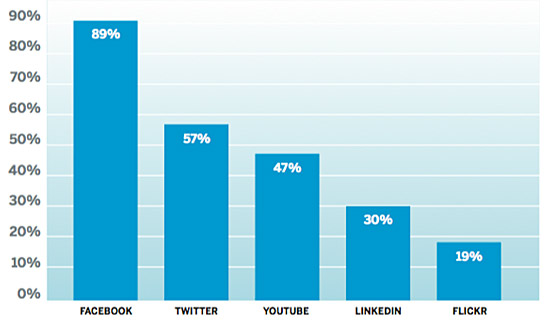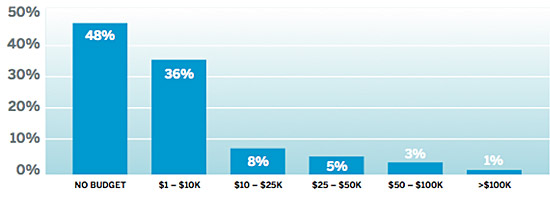
Wide use of social media by the Christopher & Dana Reeve Foundation.
A look at how nonprofits are using social media to fund-raise for social good
Guest post by Frank Barry
Director, Professional Services, Blackbaud
 According to a study by Blackbaud, NTEN and Common Knowledge, over 92 percent of nonprofit organizations have a presence on at least one social networking site, but most raise very little money through their social activity.
According to a study by Blackbaud, NTEN and Common Knowledge, over 92 percent of nonprofit organizations have a presence on at least one social networking site, but most raise very little money through their social activity.
In fact, 87 percent have raised under $1,000 on Facebook since they began using the platform.
A big part of what holds nonprofit organizations back is the fact that they can’t risk full-fledged social media adoption because they’re short staffed and must focus on creating revenue and running programs — helping real people in the real world.
Yet despite the lack of widespread fundraising success, social media is clearly a hot topic in the nonprofit space. Conferences dedicated to helping nonprofits learn how to leverage social media for social good are popping up. Big social fundraising days coupled with workshops and other training events are taking advantage of the groundswell of social fundraising activity. And large online publications like Mashable are even covering social media for social good.
According to Darian Rodriguez Heyman, author of “Nonprofit Management 101” and creator of the Social Media for Nonprofits conference, “In a world where Facebook is the equivalent of the third largest country on the planet, we have to ask ourselves, ‘How can nonprofits leverage the immense word-of-mouth potential that social media makes available to causes both large and small?’ Nonprofit leaders need practical tips and tools for fundraising, marketing, and advocacy if they are to maximize impact online and in general.”
So what is holding nonprofit organizations back and how are the top 1 percent succeeding? It’s clear from the data below that three big things contribute to the lack of fundraising success: 1) lack of budget, 2) lack of staffing, and 3) lack of focus on raising money.
Social media adoption by platform
Heading into 2011, most nonprofits (92%), regardless of organization size, are using at least one commercial social network like Facebook, Twitter or LinkedIn.
The industry giant, with 89% adoption among nonprofits, is Facebook. Twitter is the second most popular, used by 57% of organizations, with YouTube, LinkedIn and Flickr rounding out the top five.

Social media adoption by budget
More than half (52%) of nonprofits have no formal budgets for social networks with just 4% allocating more than $50,000 annually.

Social media adoption by staffing
On the staffing side, 86% of nonprofits commit some employee time to social networks, with the majority (61%) allocating a quarter of a full-time employee, and nearly 15% dedicating three-quarters or more of a full-time staffer.
But if you look closely you’ll notice that 86% of nonprofits commit one-half or less of a full-time staffer.

Social media adoption by fundraising
Fifty-eight percent of nonprofits report measuring at least the soft benefits — e.g., increased awareness, education, non-financial supporter participation — of their commercial social networks. Just 9 percent measure return on investment (ROI), or revenue received from donors, sponsors, advertisers, etc.
It’s important to note that 35 percent have raised less than $1,000, and a very thin slice of less than 1 percent of all nonprofits have raised more than $100,000 via Facebook in the past year.

How are the top 1% achieving success?
The numbers are interesting and all, but what’s the thing that separates those top 1 percent performers from the rest of the pack? And how can any nonprofit, large or small, put big numbers on the board?
The answer is as simple as 1, 2, 3. Here are three ways for nonprofits to raise big dollars online:
1) Hire or assign someone currently on staff. Nothing good can happen if no one’s working on it. It’s a pretty logical bit of reasoning, but judging by the data, nonprofits don’t allocate much staff time to social media.
Take a look at organizations like Make-a-Wish Foundation, Best Friends Animal Society, Christopher and Dana Reeve Foundation, American Red Cross, National Wildlife Federation, Humane Society and March of Dimes. Every one of these nonprofits has at least one person on staff that owns their social media program. Some even have full-blown teams. If you’re trying to leverage the social Web and all it has to offer, at some point you’re going to have to put resources on the job.
2) Allocate budget. We all know you have to spend money to make money. Nonprofits spend money on direct mail, email, websites, big events, and much more as part of their fundraising strategy. None of it is free, so why would the effective use of social media be any different?
Those who are finding social media to be an effective fundraising channel spend money on things like custom Facebook pages, Facebook ads, Facebook apps, promoted tweets, professional social media engagement platforms, blogs, content creation, campaign integration and much more. It doesn’t have to be an enormous amount of money, but if you want to raise significant dollars, you have to invest.
3) Add social media components to your fundraising appeals. Now that you’ve put someone in charge of your social media use and allocated some budget, it’s time to get to work, but instead of blowing things way out of proportion, start thinking of ways to incorporate social media into your existing fundraising efforts.
You probably have an end of year fundraising appeal that you distribute through direct mail, email and your website, right? Why not get creative this time around and use Facebook to generate two-way engagement in the form of people sharing why they support your organization, Twitter to tell the masses and YouTube to create a personalized thank-you video for all those who donate?
The key is to infuse your current fundraising activity with social media rather than try to dream up a totally new way of raising money.
Conclusion: Do these 3 things and thrive! Agree or disagree? Please share in the comments.
 This work is licensed under a Creative Commons Attribution-NonCommercial 3.0 Unported.
This work is licensed under a Creative Commons Attribution-NonCommercial 3.0 Unported.









Great post, your 3 recommendations are spot on! One item I would add is including social media links to all marketing pieces and correspondence. Email for example is a critical component to integrate with social media plans. Just recently I wrote about 4 tips for building a strong fundraising email program. Stop by and have a read when you get a chance: http://www.miratelinc.com/blog/4-tips-for-building-a-strong-nonprofit-fundraising-email-program/
Thanks for sharing, Desi!
Thanks Desi. Appreciate you taking the time to share!! You make a GREAT point about including social sharing links in all marketing – that’s a great way to beef up any communication.
I think these are great stats to know. I agree that most organizations do not fully utilize social media and it should be part of the budget. The fact that they’re not raising social media through their channels does not mean its not effective. If social media first engaged a donor to come to an event where a donation was cultivated, then it was effective, but the numbers do not correlate. If social media is implemented well there should be more benefits than just online donations, thus this is where tracking social media or any marketing gets tricky. (http://givingtreeassociates.com/)
Great post Frank,
Many people have been talking about how the connection between social media and fundraising is tenuous, but I think what your article is indicating is that the link is not tenuous.